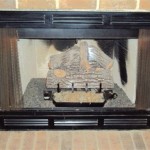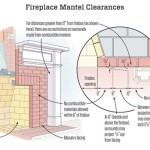How To Convert A Wood Burning Fireplace to a Gas Insert
Converting a wood-burning fireplace to a gas insert is a significant home improvement project that can enhance the fireplace's efficiency, convenience, and overall safety. A gas insert offers a cleaner burning alternative to wood, reducing particulate emissions and eliminating the need to gather, store, and haul firewood. This article provides a comprehensive guide to understanding the process, considerations, and steps involved in converting a wood-burning fireplace to a gas insert system.
Before embarking on this project, careful planning and assessment are crucial. Understanding the different types of gas inserts, the specific requirements of the existing fireplace, and local building codes are essential for a successful conversion.
I. Assessing the Existing Fireplace
The initial step involves a thorough inspection of the existing wood-burning fireplace. This assessment will determine the fireplace's suitability for a gas insert and identify any necessary repairs or modifications. Key aspects to consider include:
Fireplace Dimensions: Accurately measure the firebox opening, height, width, and depth. These dimensions are critical for selecting a gas insert that fits properly within the existing space. Most manufacturers provide detailed specifications for their inserts, including minimum and maximum firebox dimensions. It's imperative that the selected insert comfortably fits within these parameters. Insufficient clearance can lead to overheating and safety hazards. Too much space, and the aesthetics will be off.
Chimney Condition: The chimney's structural integrity and condition are paramount. A damaged or deteriorated chimney can pose serious safety risks, including the potential for carbon monoxide leaks. Inspect the chimney for cracks, loose bricks, or crumbling mortar. If any damage is detected, it must be repaired before installing a gas insert. Often, a chimney liner is required to ensure proper venting of the combustion gases produced by the gas insert. This liner is typically made of stainless steel and is installed inside the existing chimney flue.
Hearth and Firebox Construction: Examine the hearth and firebox for any signs of damage or deterioration. Cracks or crumbling bricks should be repaired to ensure the structural stability of the fireplace. The hearth must also be of sufficient size and material to protect the surrounding floor from heat. Check the integrity of the damper. In many cases, the damper needs to be permanently locked open or removed entirely to accommodate the vent pipe of the gas insert.
Local Building Codes and Regulations: Before starting any work, research and understand local building codes and regulations regarding fireplace conversions and gas appliance installations. These codes often dictate specific requirements for venting, gas line connections, and safety features. Obtain any necessary permits before beginning the project. Failure to comply with local codes can result in fines and the requirement to remove the installation.
II. Selecting the Appropriate Gas Insert
Choosing the right gas insert is crucial for achieving the desired heating performance, aesthetic appeal, and energy efficiency. There are several factors to consider when selecting a gas insert:
Gas Type (Natural Gas or Propane): Gas inserts are designed to operate on either natural gas or propane. Determine which fuel source is available and select an insert that is compatible. Converting an insert from one gas type to another is generally not recommended and can void the warranty. The choice often depends on the existing infrastructure of the home. Natural gas is often more cost-effective where available, while propane provides flexibility where natural gas lines are absent.
Heating Capacity (BTU Rating): The heating capacity of a gas insert is measured in British Thermal Units (BTU). Choose an insert with a BTU rating appropriate for the size of the room or area you intend to heat. An insert with a too-low BTU rating will struggle to heat the space effectively, while an insert with a too-high BTU rating may overheat the room. Evaluate the square footage of the space and consider factors such as insulation levels and ceiling height when determining the appropriate BTU rating. Consult with a qualified professional to accurately assess your heating needs.
Venting System: Gas inserts typically require either a direct vent or a B-vent system. A direct vent system draws air from outside the home and vents exhaust gases directly outside. This type of system is highly efficient and minimizes the risk of backdrafting. A B-vent system uses the existing chimney to vent exhaust gases. The condition of the chimney is especially important when using a B-vent system. Select a venting system that meets local building codes and is compatible with the existing chimney configuration. Direct vent systems often offer greater flexibility in installation, as they don't rely on the existing chimney to the same extent as B-vent systems.
Features and Aesthetics: Gas inserts are available with a variety of features and aesthetic options. Consider features such as thermostatic control, remote control operation, and variable flame height. Aesthetic options include different log sets, firebox liners, and decorative fronts. Choose an insert that complements the style of your home and provides the desired level of convenience and control. Some inserts also offer features like blowers to circulate warm air more effectively or safety features like oxygen depletion sensors (ODS).
Efficiency Ratings: Look for gas inserts with high efficiency ratings, which will save money on energy bills and reduce environmental impact. Efficiency is typically measured by the Annual Fuel Utilization Efficiency (AFUE). A higher AFUE rating indicates a more efficient appliance. Energy Star certified models often meet or exceed minimum efficiency standards.
III. Installation Process
The installation of a gas insert is a complex task that requires specialized knowledge and skills. It is strongly recommended that the installation be performed by a qualified and licensed professional. However, understanding the steps involved can help homeowners oversee the project and ensure that it is completed correctly.
Preparation: Clear the area around the fireplace and protect the surrounding floor and furniture. Disconnect any existing electrical or gas connections to the fireplace. Thoroughly clean the firebox and chimney. Ensure that the chimney is free of obstructions and debris. Prepare the necessary tools and materials, including the gas insert, venting system, gas piping, and any required connectors or fittings.
Gas Line Installation: A gas line must be installed from the main gas supply to the fireplace location. This work should be performed by a licensed gas fitter. The gas line must be properly sized to provide adequate gas flow to the insert. All connections must be leak-tested to ensure safety. Local codes often specify the type of piping and fittings that must be used for gas line installations. Safety is paramount, and any gas leaks can pose a significant risk of explosion or carbon monoxide poisoning.
Venting System Installation: Install the venting system according to the manufacturer's instructions and local building codes. For a direct vent system, the vent pipe must be run through an exterior wall and terminated properly. For a B-vent system, the chimney liner must be installed and connected to the gas insert. Ensure that all connections are sealed tightly to prevent leaks. Proper venting is essential for safe and efficient operation of the gas insert. Incorrectly installed venting can lead to backdrafting, carbon monoxide buildup, and reduced heating performance.
Insert Placement: Carefully position the gas insert in the firebox, ensuring that it is level and securely supported. Connect the gas line and venting system to the insert, following the manufacturer's instructions. Double-check all connections for leaks. Pay close attention to clearances specified by the manufacturer to prevent overheating and ensure proper ventilation.
Electrical Connections: Connect the gas insert to the electrical system if required. Some inserts require electrical power for features such as blowers, igniters, and remote controls. Ensure that the electrical connections are properly grounded and meet local electrical codes. Using a surge protector is recommended to protect the insert's electronic components from power surges.
Testing and Calibration: After installation, thoroughly test the gas insert to ensure that it is operating correctly. Check the flame pattern, gas pressure, and venting system. Calibrate the thermostat and other controls as needed. Monitor the insert for any signs of malfunction or leaks. A carbon monoxide detector should be installed in the vicinity of the fireplace as a safety measure.
Finishing Touches: Install any decorative fronts, log sets, or other accessories. Clean up the work area and remove any debris. Inspect the installation to ensure that it meets all safety and aesthetic requirements. It is a good practice to document the installation with photographs and keep records of all permits, inspections, and warranties.
Professional Inspection: Arrange for a professional inspection of the completed installation. A qualified inspector can verify that the gas insert has been installed correctly and that it meets all applicable codes and regulations. This inspection will provide peace of mind and ensure the safety of the installation.
Converting a wood-burning fireplace to a gas insert can provide a number of benefits, including increased convenience, improved efficiency, and reduced emissions. By carefully assessing the existing fireplace, selecting the appropriate gas insert, and following the proper installation procedures, homeowners can enjoy the warmth and ambiance of a gas fireplace while minimizing the risks associated with wood-burning.

Convert From Wood To Gas With A Insert The Kernel Burner

Gas To Wood Fireplace Conversion Overland Park Ks Firplace Service

Convert From Wood To Gas With A Insert The Kernel Burner

Convert To Gas Installing Fireplace Inserts Doctor Flue

Can A Wood Burning Fireplace Be Converted To Gas The Flame Company

Update Your Wood Fireplace To A Gas

How To Convert Your Wood Burning Fireplace Electric Or Gas

Want To Convert Gas Wood Fireplace Full Service Chimney

Want To Convert Gas Wood Fireplace Full Service Chimney

Should You Convert Your Cabin Fireplace From Wood To Gas
Related Posts








